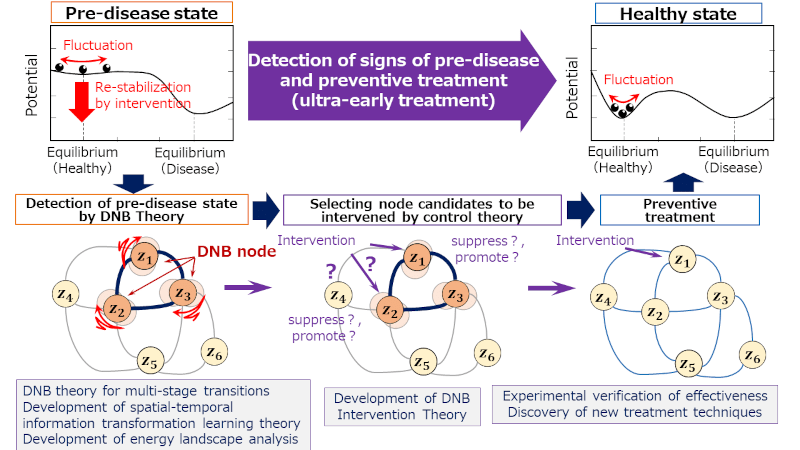Progress Report
Comprehensive Mathematical Understanding of the Complex Control System between Organs and Challenge for Ultra-Early Precision Medicine[1] Mathematical Approach to Complex Control System between Organs
Progress until FY2024
1. Outline of the project
The process to the onset of a disease is understood as state transition of the complex interaction network between organs, cells, and genes. A method called Dynamical Network Biomarkers (DNB) has been proposed to detect the pre-disease states by focusing on the "fluctuations" in gene mRNA expression levels, hormone concentrations and others. The effectiveness of DNB has been demonstrated for various diseases. However, research on preventive treatment when such a pre-disease state is detected remains limited.
Our mathematical goal is to expand DNB theory to multi-stage transitions, develop its complementary theory on spatiotemporal information transformation and energy landscape analysis, and then establish preventive network treatment in pre-disease states by combining DNB theory and control theory.

2. Outcome so far
In FY2023, we extended DNB intervention theory for gene networks to include interventions in both mRNA expression and protein production by using a reduced mRNA-based model. In FY2024, we successfully developed DNB intervention theory via a hierarchical network model of mRNA and proteins without relying on model reduction. This allows us to identify gene candidates to be intervened in both cases: when only mRNA is observable and when both mRNA and protein levels are available regardless of whether the intervention targets are mRNA or proteins. When only mRNA is observable, we can narrow down candidate genes partially using intervention indicators. When both mRNA and protein are observable, we can fully derive the indicators and uniquely identify the target genes. As an extension of this theory to organ networks, we further established a foundation for DNB analysis in metabolic regulatory systems.
We have also proposed mathematical methods to detect warning signals of multi-stage successive transitions (Nat Comm, 2024) and new theory to complement the DNB theory so that we can detect early warning signals for small deviation from healthy states at ultra-early timing. Further, as an urgent important problem of our society, we studied COVID-19 and found a key gene DOCK2 for severe COVID-19 (Nature, 2022) and optimal isolation guidelines (Nat Comm, 2022; 2024) for COVID-19 and Mpox patients.
In collaboration with the Saito group at U. Toyama and the Hayashi group at Kyoto Pharmaceutical Univ. for experimental validation and Fujiwara group at U. Tokyo for data management, we continued studies of DNB intervention (mRNA intervention) using multi-organ data from metabolic syndrome model mice, and we applied the DNB intervention theory developed in this year to gene expression data from inflammatory bowel disease (IBD) model mice. As a result of conducting protein-level interventions using antibodies etc., we demonstrated the effectiveness of this method for two target genes. Furthermore, we have successfully observed multi-stage state transitions in lung cancer mice (Nat Comm, 2024). On the basis of these results, our experimental group is currently working on extending the analysis to human data.

3. Future plans
We have expanded the DNB intervention theory to include both mRNA and protein interventions. Future challenges include extending this theory to hierarchical networks of genes and cells and adapting it for single-cell sequencer data. It is also our important future problem to combine the DNB theory with its complementary theory and advanced AI technology toward a comprehensive systems analysis for ultra-early medicine of many diseases.